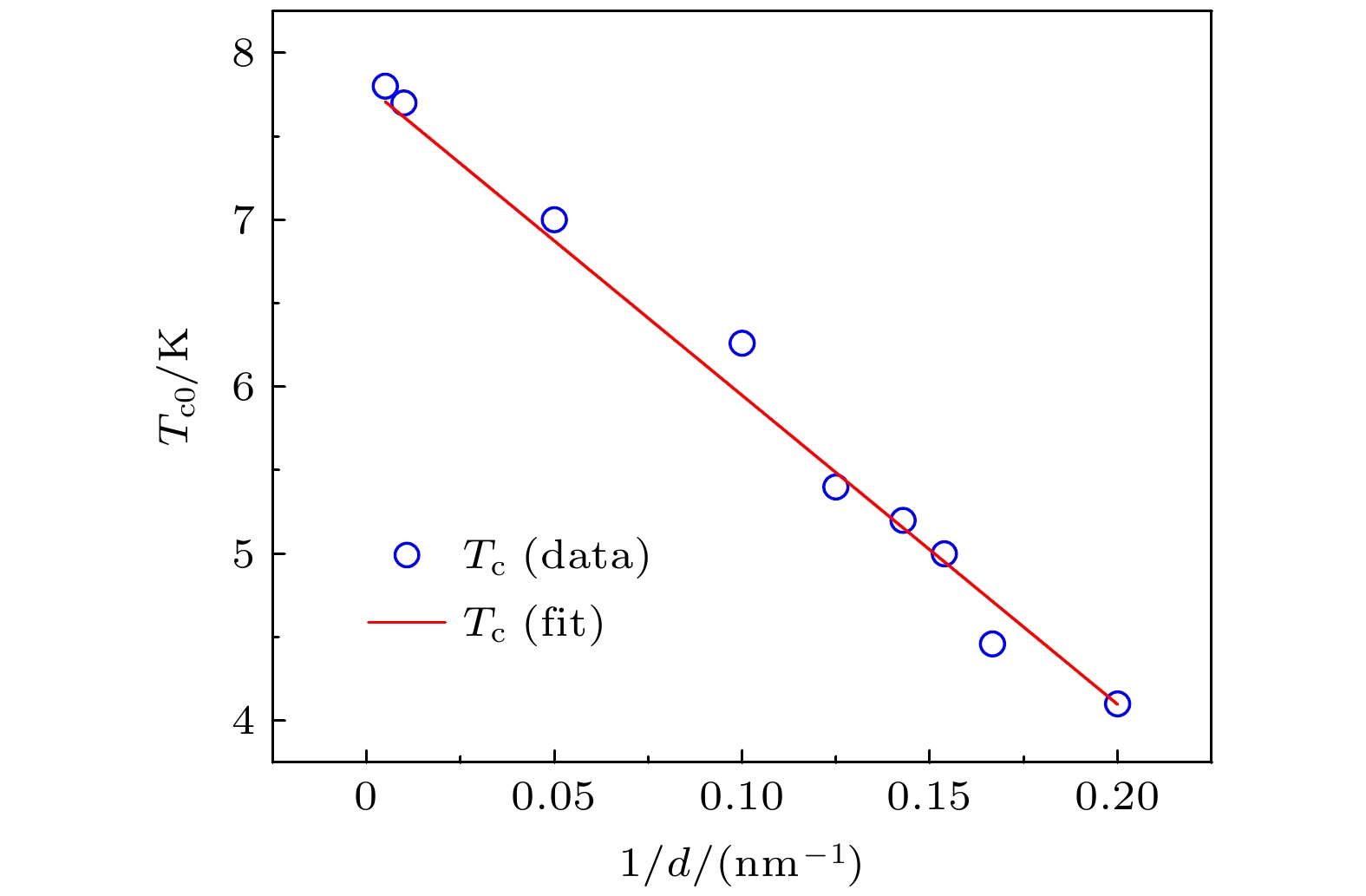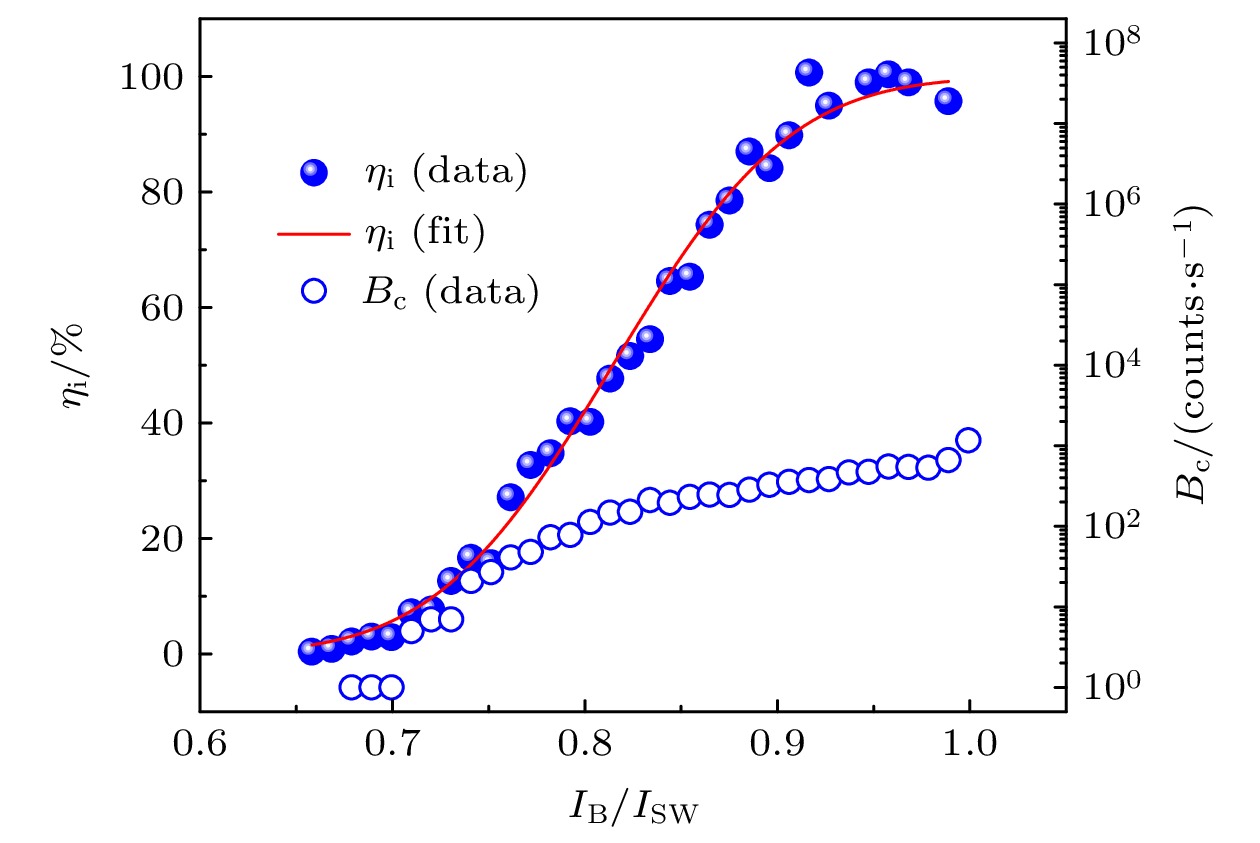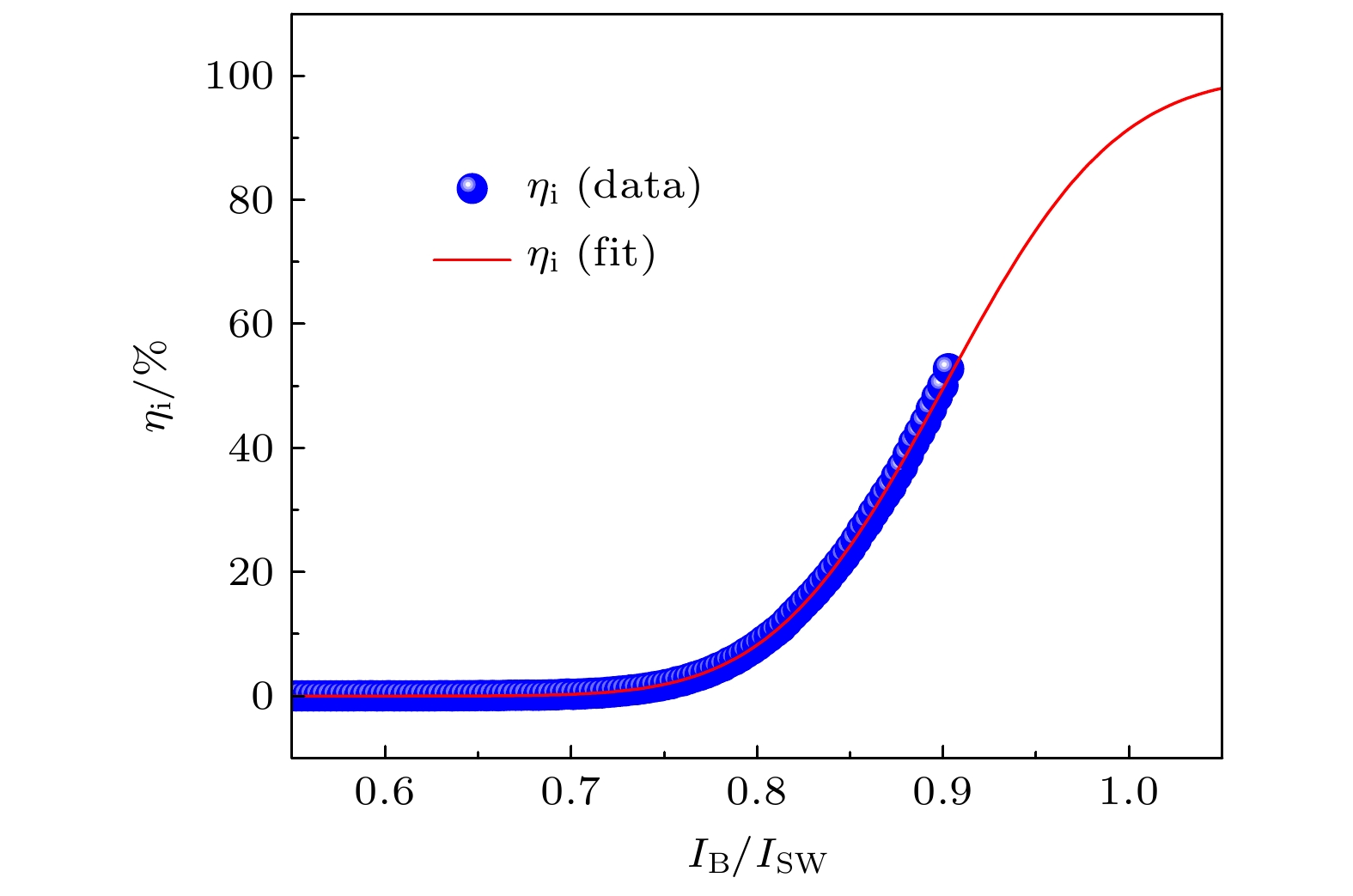-
高性能的中长波单光子探测器在红外天文和军事国防领域具有重要的研究价值, 也是单光子探测技术领域的研究难点. 超导纳米线单光子探测器在近红外波段已经展示出优异的性能, 但如何进一步提高器件的探测截止波长λc是一个受到广泛关注的话题. 本文探讨了一种通过超导无序调控辅助提高λc的方法, 设计并制备出工作波段为5—10 μm的超导单光子探测器. 理论分析表明, 增大衡量无序强度的主要评价因子即薄膜方块电阻Rs, 将有利于增大λc, 如当纳米线宽保持在30 nm且Rs > 380 Ω/square时, 可使得λc > 10 μm. 实验测得Rs约为320 Ω/square的Mo0.8Si0.2红外器件在6 μm波长上可以获得完全饱和的量子效率. 此外, 当器件工作在0.9ISW (ISW为纳米线超导转变电流)的偏置电流下时, 在10.2 μm波长上的量子效率达到53%.
High-performance mid-wave and long-wave infrared single-photon detectors not only have significant research value in the fields of infrared astronomy and defense technology, but also are the challenges in the field of single-photon detection technology. Superconducting nanowire single-photon detectors (SNSPDs) have shown excellent performances in the near-infrared band. However, how to further improve the cutoff wavelength λc is a topic of widespread concern. In this paper, the method of improving λc by regulating the superconducting disorder is discussed, and a detector with an operating wavelength band of 5–10 μm is designed and fabricated. The studies show that the multiplication and diffusion behaviors of the quasiparticles always occur during the photon detection events, although the microscopic photodetection mechanism of SNSPD still lacks a perfect theoretical explanation. Therefore, the theoretical analysis mainly considers the influence of the quasiparticles in this paper, and the mathematical formula of the detection cutoff wavelength λc can be obtained based on the phenomenological quasiparticle diffusion model. Furthermore, the disorder-dependent superconducting phase transition temperature Tc, superconducting energy gap Δ, and electron thermalization time τth are also considered, in order to obtain more precise results. Theoretical analysis suggests that the increase in the sheet resistance Rs, which evaluates the disorder strength, will help to increase λc. For example, when the nanowire width is kept at 30 nm and Rs > 380 Ω/square, it can be deduced that λc is larger than 10 μm. Experimentally, the active area of the device consists of a straight superconducting nanowire with a length of 10 μm and a width of 30 nm, so that it can effectively reduce the probability of the defects on the nanowire and avoid the current crowding effect. We fabricate a 30 nm-wide Mo0.8Si0.2 mid infrared SNSPD, which has a cutoff wavelength λc no more than 5 μm, the effective strength of the disorder-the film sheet resistance Rs = 248.6 Ω/square. For comparison, the sheet resistance, which is controlled by the film thickness, increases to about 320 Ω/square in this experiment. It is demonstrated that the Mo0.8Si0.2 detector with Rs $ \sim $ 320 Ω/square can achieve saturated quantum efficiency at a wavelength of 6 μm. Furthermore, 53% quantum efficiency at a wavelength of 10.2 μm can be obtained when the detector works at a bias current of 0.9ISW (ISW is the superconducting transition current), and it can theoretically reach a maximum value of 92% if the compression of switching current is excluded. Therefore, it can be predicted that the disorder regulation may become another efficient approach to designing high-performance mid-wave and long-wave infrared SNSPDs, in addition to the optimization of the superconducting energy gap and the cross section of superconducting nanowire.However, the continuous increase in the disorder will cause both the superconducting phase transition temperature Tc and ISW of the detector to decrease from the viewpoint of detector fabrication and application. This downward trend is especially pronounced when the nanowire width is ultranarrow, which is not conducive to the signal readout of the detector. Thus, exploring the optimal disorder regulation technology and balancing the relationship among the operating temperature, the signal-to-noise ratio, and the cutoff wavelength will have key scientific and application value for the development of high-performance mid-wave and long-wave infrared SNSPDs. -
Keywords:
- mid-wave and long-wave infrared /
- single-photon detection /
- superconducting nanowire /
- disorder
[1] Reddy D V, Nerem R R, Nam S W, Mirin R P, Verma V B 2020 Optica 7 1649
 Google Scholar
Google Scholar
[2] Chang J, Los J W N, Tenorio-Pearl J O, Noordzij N, Gourgues R, Guardiani A, Zichi J R, Pereira S F, Urbach H P, Zwiller V, Dorenbos S N, Esmaeil Zadeh I 2021 APL Photonics 6 036114
 Google Scholar
Google Scholar
[3] Korzh B, Zhao Q Y, Allmaras J P, et al. 2020 Nat. Photonics 14 250
 Google Scholar
Google Scholar
[4] Wollman E E, Verma V B, Walter A B, Chiles J, Korzh B, Allmaras J P, Zhai Y, Lita A E, McCaughan A N, Schmidt E, Frasca S, Mirin R P, Nam S W, Shaw M D 2021 J. Astron. Telesc. Instruments, Syst. 7 1
[5] Chen L, Lau J A, Schwarzer D, Meyer J, Verma V B, Wodtke A M 2019 Science 363 158
 Google Scholar
Google Scholar
[6] US DARPA 2021 Selects Research Teams For Invisible Headlights Programme [2021-07-13]
[7] Engel A, Inderbitzin K, Schilling A, Lusche R, Semenov A, Hübers H W, Henrich D, Hofherr M, Il’in K, Siegel M 2013 IEEE Trans. Appl. Supercond. 23 2300505
 Google Scholar
Google Scholar
[8] Engel A, Renema J J, Il’in K, Semenov A 2015 Supercond. Sci. Technol. 28 114003
 Google Scholar
Google Scholar
[9] Verma V B, Korzh B, Walter A B, Lita A E, Briggs R M, Colangelo M, Zhai Y, Wollman E E, Beyer A D, Allmaras J P, Vora H, Zhu D, Schmidt E, Kozorezov A G, Berggren K K, Mirin R P, Nam S W, Shaw M D 2021 APL Photonics 6 056101
 Google Scholar
Google Scholar
[10] Chen Q, Ge R, Zhang L, Li F, Zhang B, Jin F, Han H, Dai Y, He G, Fei Y, Wang X, Wang H, Jia X, Zhao Q, Tu X, Kang L, Chen J, Wu P 2021 Sci. Bull. 66 965
 Google Scholar
Google Scholar
[11] Dubi Y, Meir Y, Avishai Y 2007 Nature 449 876
 Google Scholar
Google Scholar
[12] Sacépé B, Dubouchet T, Chapelier C, Sanquer M, Ovadia M, Shahar D, Feigel’man M, Ioffe L 2011 Nat. Phys. 7 239
 Google Scholar
Google Scholar
[13] Sacépé B, Chapelier C, Baturina T I, Vinokur V M, Baklanov M R, Sanquer M 2008 Phys. Rev. Lett. 101 157006
 Google Scholar
Google Scholar
[14] Frasca S, Korzh B, Colangeloet M, et al. 2019 Phys. Rev. B 100 054520
 Google Scholar
Google Scholar
[15] Finkel’stein A M 1994 Phys. B Condens. Matter 197 636
 Google Scholar
Google Scholar
[16] Semenov A, Engel A, Hübers H W, Il’in K, Siegel M 2005 Eur. Phys. J. B 47 495
 Google Scholar
Google Scholar
[17] Carrington A, Manzano F 2003 Phys. C Supercond. 385 205
 Google Scholar
Google Scholar
[18] Ivry Y, Kim C S, Dane A E, De Fazio D, McCaughan A N, Sunter K A, Zhao Q, Berggren K K 2014 Phys. Rev. B 90 214515
[19] Li F, Han H, Chen Q, Zhang B, Bao H, Dai Y, Ge R, Guo S, He G, Fei Y, Yang S, Wang X, Wang H, Jia X, Zhao Q, Zhang L, Kang L, Wu P 2021 Photonics Res. 9 389
 Google Scholar
Google Scholar
[20] Simonin J 1986 Phys. Rev. B 33 7830
 Google Scholar
Google Scholar
[21] Chen Q, Zhang B, Zhang L B, Li F Y, Jin F F, Han H, Ge R, He G L, Li H C, Tan J R, Wang X H, Wang H, Yu S L, Jia X Q, Zhao Q Y, Tu X C, Kang L, Chen J, Wu P H 2022 Phys. Rev. B 105 014516
 Google Scholar
Google Scholar
[22] Kupriyanov M Y, Lukichev V F 1980 Sov. J. Low Temp. Phys. 6 210
[23] Zhang L, You L, Yang X, Tang Y, Si M, Yan K, Zhang W, Li H, Zhou H, Peng W, Wang Z 2019 Appl. Phys. Lett. 115 132602
 Google Scholar
Google Scholar
[24] Yamashita T, Miki S, Makise K, Qiu W, Terai H, Fujiwara M, Sasaki M, Wang Z 2011 Appl. Phys. Lett. 99 161105
 Google Scholar
Google Scholar
[25] Kozorezov A G, Lambert C, Marsili F, Stevens M J, Verma V B, Allmaras J P, Shaw M D, Mirin R P, Nam S W 2017 Phys. Rev. B 96 054507
 Google Scholar
Google Scholar
[26] Yang C, Liu Y, Wang Y, Feng L, He Q, Sun J, Tang Y, Wu C, Xiong J, Zhang W, Lin X, Yao H, Liu H, Fernandes G, Xu J, Valles J M, Wang J, Li Y 2019 Science 366 1505
 Google Scholar
Google Scholar
[27] Brun C, Cren T, Cherkez V, Debontridder F, Pons S, Fokin D, Tringides M C, Bozhko S, Ioffe L B, Altshuler B L, Roditchev D 2014 Nat. Phys. 10 444
 Google Scholar
Google Scholar
[28] Colangelo M, Walter A B, Korzh B A, Schmidt E, Bumble B, Lita A E, Beyer A D, Allmaras J P, Briggs R M, Kozorezov A G, Wollman E E, Shaw M D, Berggren K K 2022 Nano Lett. 22 5667
 Google Scholar
Google Scholar
[29] Zhang W, Jia Q, You L, Ou X, Huang H, Zhang L, Li H, Wang Z, Xie X 2019 Phys. Rev. Appl. 12 044040
 Google Scholar
Google Scholar
-
图 2 (a) 超导薄膜方块电阻Rs与纳米线宽w对纳米线的超导相变温度Tc的影响; (b) 超导薄膜方块电阻Rs与纳米线宽w对纳米线的破对电流
${I}_{\rm{d}\rm{e}\rm{p}}^{\rm{K}\rm{L}} $ 的影响,${I}_{\rm{d}\rm{e}\rm{p}}^{\rm{K}\rm{L}} $ 随着Rs的增大以及w的减小而降低, 图中白色和黄色虚线分别表示${I}_{\rm{d}\rm{e}\rm{p}}^{\rm{K}\rm{L}} $ 为3 μA和10 μA时的计算结果Fig. 2. (a) Effects of the film sheet resistance Rs and the nanowire width w on the superconducting phase transition temperature Tc; (b) effects of Rs and w on the depairing current
${I}_{\rm{d}\rm{e}\rm{p}}^{\rm{K}\rm{L}} $ , it can be shown that${I}_{\rm{d}\rm{e}\rm{p}}^{\rm{K}\rm{L}} $ decreases with increasing Rs and decreasing w, and the white and yellow dashed lines represent the${I}_{\rm{d}\rm{e}\rm{p}}^{\rm{K}\rm{L}} $ calculation results of 3 μA and 10 μA, respectively.图 3 (a) 当SNSPD的最大偏置电流IB可达到0.9
${I}_{\rm{d}\rm{e}\rm{p}}^{\rm{K}\rm{L}} $ 时, 超导薄膜方块电阻Rs与纳米线宽w对SNSPD探测截止波长λc的影响; (b) 当SNSPD的最大偏置电流IB降低到0.5${I}_{\rm{d}\rm{e}\rm{p}}^{\rm{K}\rm{L}} $ 时, Rs与w对λc的影响 (图中绿色、黄色以及白色三条虚线分别表示三个λc的刻度线, 如当(w, Rs)的坐标点处于白色虚线上方时, λc > 10 μm)Fig. 3. (a) Effects of the film sheet resistance Rs and the nanowire width w on the cutoff wavelength λc when the maximum bias current IB of the SNSPD can reach 0.9
${I}_{\rm{d}\rm{e}\rm{p}}^{\rm{K}\rm{L}} $ ; (b) effects of Rs and w on λc when the maximum IB can only reach 0.5${I}_{\rm{d}\rm{e}\rm{p}}^{\rm{K}\rm{L}} $ (Green, yellow, and white dashed lines represent the scale lines of the three λc values. For example, if the coordinate point of (w, Rs) stays above the white dashed line, λc > 10 μm).图 4 (a) 器件结构图, 主要包含用于信号脉冲展宽的蜿蜒纳米线结构和响应红外光子的窄纳米线, 这里为避免窄纳米线在制备过程中发生漂移, 在窄纳米线上增加了多个“十字”结构; (b) 信号脉冲展宽蜿蜒纳米线的局部SEM图, 纳米线宽为180 nm; (c) 窄纳米线的局部放大图; (d) 窄纳米线的局部SEM图, 测量得到纳米线的宽度为30 nm
Fig. 4. (a) Structure diagram of the detector, which mainly includes the signal pulse-broadened meander nanowire and the narrow nanowire that detects the infrared photons, many cross structures were added to avoid the drift behavior of narrow nanowire during the nanofabrication; (b) SEM image of the signal pulse-broadened meander nanowire, the measured nanowire width is 180 nm; (c) local magnification image of the narrow nanowire; (d) SEM image of the narrow nanowire, the measured nanowire width is 30 nm.
图 5 红外SNSPD测量示意图, 红外光源输出的信号光通过光学套筒、可调中性密度衰减器、窄带滤波片、稀释制冷机的ZnSe光学窗口以及制冷机内部的固定衰减器(光密度Od = 3), 最终覆盖SNSPD的光敏面. SNSPD吸收单光子并将其转化为一个电脉冲信号, 电脉冲信号通过外部电路进行放大并读出, 从而完成一次光子探测
Fig. 5. In the measurement diagram of the infrared SNSPD, the signal photons are emitted from the light source and finally arrive at the active area of the detector through the optical sleeve, the adjustable neutral density attenuator, the narrow band filter, the ZnSe optical window of the diluted refrigerator, and the fixed attenuator inside the refrigerator (with an optical density Od = 3). The SNSPD absorbs one photon and converts it to an electrical pulse, and the pulse is amplified and read through the external circuit; thus, a photon detection event is finished.
-
[1] Reddy D V, Nerem R R, Nam S W, Mirin R P, Verma V B 2020 Optica 7 1649
 Google Scholar
Google Scholar
[2] Chang J, Los J W N, Tenorio-Pearl J O, Noordzij N, Gourgues R, Guardiani A, Zichi J R, Pereira S F, Urbach H P, Zwiller V, Dorenbos S N, Esmaeil Zadeh I 2021 APL Photonics 6 036114
 Google Scholar
Google Scholar
[3] Korzh B, Zhao Q Y, Allmaras J P, et al. 2020 Nat. Photonics 14 250
 Google Scholar
Google Scholar
[4] Wollman E E, Verma V B, Walter A B, Chiles J, Korzh B, Allmaras J P, Zhai Y, Lita A E, McCaughan A N, Schmidt E, Frasca S, Mirin R P, Nam S W, Shaw M D 2021 J. Astron. Telesc. Instruments, Syst. 7 1
[5] Chen L, Lau J A, Schwarzer D, Meyer J, Verma V B, Wodtke A M 2019 Science 363 158
 Google Scholar
Google Scholar
[6] US DARPA 2021 Selects Research Teams For Invisible Headlights Programme [2021-07-13]
[7] Engel A, Inderbitzin K, Schilling A, Lusche R, Semenov A, Hübers H W, Henrich D, Hofherr M, Il’in K, Siegel M 2013 IEEE Trans. Appl. Supercond. 23 2300505
 Google Scholar
Google Scholar
[8] Engel A, Renema J J, Il’in K, Semenov A 2015 Supercond. Sci. Technol. 28 114003
 Google Scholar
Google Scholar
[9] Verma V B, Korzh B, Walter A B, Lita A E, Briggs R M, Colangelo M, Zhai Y, Wollman E E, Beyer A D, Allmaras J P, Vora H, Zhu D, Schmidt E, Kozorezov A G, Berggren K K, Mirin R P, Nam S W, Shaw M D 2021 APL Photonics 6 056101
 Google Scholar
Google Scholar
[10] Chen Q, Ge R, Zhang L, Li F, Zhang B, Jin F, Han H, Dai Y, He G, Fei Y, Wang X, Wang H, Jia X, Zhao Q, Tu X, Kang L, Chen J, Wu P 2021 Sci. Bull. 66 965
 Google Scholar
Google Scholar
[11] Dubi Y, Meir Y, Avishai Y 2007 Nature 449 876
 Google Scholar
Google Scholar
[12] Sacépé B, Dubouchet T, Chapelier C, Sanquer M, Ovadia M, Shahar D, Feigel’man M, Ioffe L 2011 Nat. Phys. 7 239
 Google Scholar
Google Scholar
[13] Sacépé B, Chapelier C, Baturina T I, Vinokur V M, Baklanov M R, Sanquer M 2008 Phys. Rev. Lett. 101 157006
 Google Scholar
Google Scholar
[14] Frasca S, Korzh B, Colangeloet M, et al. 2019 Phys. Rev. B 100 054520
 Google Scholar
Google Scholar
[15] Finkel’stein A M 1994 Phys. B Condens. Matter 197 636
 Google Scholar
Google Scholar
[16] Semenov A, Engel A, Hübers H W, Il’in K, Siegel M 2005 Eur. Phys. J. B 47 495
 Google Scholar
Google Scholar
[17] Carrington A, Manzano F 2003 Phys. C Supercond. 385 205
 Google Scholar
Google Scholar
[18] Ivry Y, Kim C S, Dane A E, De Fazio D, McCaughan A N, Sunter K A, Zhao Q, Berggren K K 2014 Phys. Rev. B 90 214515
[19] Li F, Han H, Chen Q, Zhang B, Bao H, Dai Y, Ge R, Guo S, He G, Fei Y, Yang S, Wang X, Wang H, Jia X, Zhao Q, Zhang L, Kang L, Wu P 2021 Photonics Res. 9 389
 Google Scholar
Google Scholar
[20] Simonin J 1986 Phys. Rev. B 33 7830
 Google Scholar
Google Scholar
[21] Chen Q, Zhang B, Zhang L B, Li F Y, Jin F F, Han H, Ge R, He G L, Li H C, Tan J R, Wang X H, Wang H, Yu S L, Jia X Q, Zhao Q Y, Tu X C, Kang L, Chen J, Wu P H 2022 Phys. Rev. B 105 014516
 Google Scholar
Google Scholar
[22] Kupriyanov M Y, Lukichev V F 1980 Sov. J. Low Temp. Phys. 6 210
[23] Zhang L, You L, Yang X, Tang Y, Si M, Yan K, Zhang W, Li H, Zhou H, Peng W, Wang Z 2019 Appl. Phys. Lett. 115 132602
 Google Scholar
Google Scholar
[24] Yamashita T, Miki S, Makise K, Qiu W, Terai H, Fujiwara M, Sasaki M, Wang Z 2011 Appl. Phys. Lett. 99 161105
 Google Scholar
Google Scholar
[25] Kozorezov A G, Lambert C, Marsili F, Stevens M J, Verma V B, Allmaras J P, Shaw M D, Mirin R P, Nam S W 2017 Phys. Rev. B 96 054507
 Google Scholar
Google Scholar
[26] Yang C, Liu Y, Wang Y, Feng L, He Q, Sun J, Tang Y, Wu C, Xiong J, Zhang W, Lin X, Yao H, Liu H, Fernandes G, Xu J, Valles J M, Wang J, Li Y 2019 Science 366 1505
 Google Scholar
Google Scholar
[27] Brun C, Cren T, Cherkez V, Debontridder F, Pons S, Fokin D, Tringides M C, Bozhko S, Ioffe L B, Altshuler B L, Roditchev D 2014 Nat. Phys. 10 444
 Google Scholar
Google Scholar
[28] Colangelo M, Walter A B, Korzh B A, Schmidt E, Bumble B, Lita A E, Beyer A D, Allmaras J P, Briggs R M, Kozorezov A G, Wollman E E, Shaw M D, Berggren K K 2022 Nano Lett. 22 5667
 Google Scholar
Google Scholar
[29] Zhang W, Jia Q, You L, Ou X, Huang H, Zhang L, Li H, Wang Z, Xie X 2019 Phys. Rev. Appl. 12 044040
 Google Scholar
Google Scholar
计量
- 文章访问数: 6473
- PDF下载量: 164
- 被引次数: 0















 下载:
下载:
















